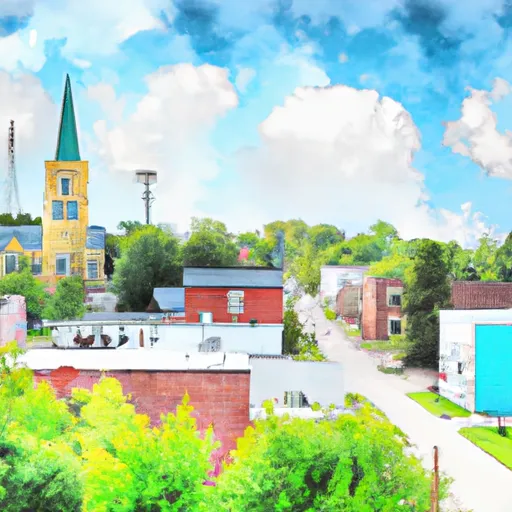-
 Snoflo Premium
Snoflo Premium
Get unlimited access to all our content
With no Ad interruptions! - Start Your Free Trial Login with existing account
Mount-Morris
Eden Index
Climate
7.4
•
Recreation
3.8
•
Community
1.5
•
Safeguard
4.7/10

Mount Morris, Michigan is a charming town located in Genesee County. It experiences a humid continental climate characterized by four distinct seasons. Summers are warm and often humid, with average temperatures ranging from 70°F to 80°F. Winters are cold and snowy, with temperatures dropping as low as 20°F. Spring and fall offer mild temperatures and colorful foliage, making them popular seasons for outdoor activities.
Mount Morris is home to several hydrology constituents, including the Flint River and several smaller tributaries. These water bodies provide scenic beauty and recreational opportunities such as fishing, kayaking, and boating. The Flint River is known for its diverse fish population, including bass, trout, and perch, attracting anglers of all skill levels.
Outdoor enthusiasts will find various recreational opportunities in Mount Morris. The city boasts several parks and green spaces where residents and visitors can enjoy activities like hiking, picnicking, and birdwatching. Additionally, nearby state parks such as Crossroads Village and Stepping Stone Falls offer opportunities for camping, swimming, and exploring nature trails.
Overall, Mount Morris offers a pleasant climate, diverse hydrology constituents, and ample outdoor recreation opportunities, making it an ideal destination for nature lovers and outdoor enthusiasts.
What is the Eden Index?
The Snoflo Eden Index serves as a comprehensive rating system for regions, evaluating their desirability through a holistic assessment of climate health, outdoor recreation opportunities, and natural disaster risk, acknowledging the profound impact of these factors on livability and well-being.
Climate Health Indicator (CHI): 7.4
Mount-Morris receives approximately
812mm of rain per year,
with humidity levels near 82%
and air temperatures averaging around
9°C.
Mount-Morris has a plant hardyness factor of
6, meaning
plants and agriculture in this region thrive during a short period during spring and early summer. Most
plants will die off during the colder winter months.
By considering the ideal temperature range, reliable water supplies, clean air, and stable seasonal rain or snowpacks, the Climate Health Indicator (CHI) underscores the significance of a healthy climate as the foundation for quality living.
A healthy climate is paramount for ensuring a high quality of life and livability in a region, fostering both physical well-being and environmental harmony. This can be characterized by ideal temperatures, reliable access to water supplies, clean air, and consistent seasonal rain or snowpacks.
Weather Forecast
Streamflow Conditions
Saginaw
Area Rivers
Saginaw
Snowpack Depths
Saginaw
Reservoir Storage Capacity
Saginaw
Groundwater Levels
Recreational Opportunity Index (ROI): 3.8
The Recreational Opportunity Index (ROI) recognizes the value of outdoor recreational options, such as parks, hiking trails, camping sites, and fishing spots, while acknowledging that climate plays a pivotal role in ensuring the comfort and consistency of these experiences.
Access to outdoor recreational opportunities, encompassing activities such as parks, hiking, camping, and fishing, is crucial for overall well-being, and the climate plays a pivotal role in enabling and enhancing these experiences, ensuring that individuals can engage in nature-based activities comfortably and consistently.
Camping Areas
| Campground | Campsites | Reservations | Toilets | Showers | Elevation |
|---|---|---|---|---|---|
| Pontiac Lake State Rec Area | 175 | 1,015 ft | |||
| Camp Dearborn | 191 | 934 ft | |||
| Bishop Lake - Brighton Rec Area | None | 901 ft | |||
| Mary Jane Thurston State Park | 35 | 644 ft | |||
| Murray Lake - Brighton Rec Area | None | 875 ft | |||
| Appleton Lake - Brighton Rec Area | None | 888 ft | |||
| Groveland Oaks County Park | None | 963 ft | |||
| Proud Lake State Rec Area | 130 | 1,002 ft | |||
| Highland State Rec Area | 40 | 977 ft | |||
| Wayne County Fairgrounds RV | None | 691 ft |
Nearby Ski Areas
Catastrophe Safeguard Index (CSI):
The Catastrophe Safeguard Index (CSI) recognizes that natural disaster risk, encompassing floods, fires, hurricanes, and tornadoes, can drastically affect safety and the overall appeal of an area.
The level of natural disaster risk in a region significantly affects safety and the overall livability, with climate change amplifying these risks by potentially increasing the frequency and intensity of events like floods, fires, hurricanes, and tornadoes, thereby posing substantial challenges to community resilience and well-being.
Community Resilience Indicator (CRI): 1.5
The Community Resilience Indicator (CRI) recognizes that education, healthcare, and socioeconomics are crucial to the well-being of a region. The CRI acknowledges the profound impact of these elements on residents' overall quality of life. By evaluating educational resources, healthcare accessibility, and economic inclusivity, the index captures the essential aspects that contribute to a thriving community, fostering resident satisfaction, equity, and social cohesion.

